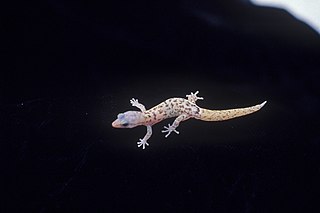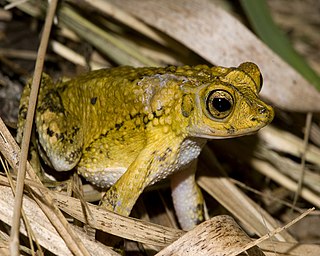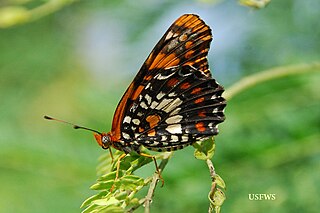
The Monito gecko is a lizard, a species of gecko endemic to the island of Monito, in the archipelago of Puerto Rico.

The Puerto Rican crested toad, or simply Puerto Rican toad, is a species of toad found only in Puerto Rico and the Virgin Islands. It is the only species of toad native to Puerto Rico and the Virgin Islands. The species formerly occurred in Virgin Gorda and along the southern and northern karst in Puerto Rico. It is listed as a threatened by the US Fish and Wildlife Service due to habitat loss and introduced species. At one period of time it was believed to be extinct until it was rediscovered in 1966. The IUCN has the species listed as critically endangered.

The Puerto Rican screech owl or Múcaro is a nocturnal endemic owl of the archipelago of Puerto Rico belonging to the genus Megascops of the family Strigidae. The subspecies, M. n. newtoni, which was endemic to the Virgin Islands, was locally referred to as the cuckoo bird.

The fauna of Puerto Rico is similar to other island archipelago faunas, with high endemism, and low, skewed taxonomic diversity. Bats are the only extant native terrestrial mammals in Puerto Rico. All other terrestrial mammals in the area were introduced by humans, and include species such as cats, goats, sheep, the small Asian mongoose, and escaped monkeys. Marine mammals include dolphins, manatees, and whales. Of the 349 bird species, about 120 breed in the archipelago, and 47.5% are accidental or rare.
The whistling coquí, Cochran's treefrog, or Cochran's robber frog is a species of frog native to Puerto Rico, the US Virgin Islands, and the British Virgin Islands. This nocturnal insectivore is also referred to as the coquí pitito in Puerto Rico. Their distinctive song is a single, rising whistle, which is repeated and followed by three clicking sounds.

The San Juan Botanical Garden, also known as the Botanical Garden of the University of Puerto Rico, is located in the Caribbean city of San Juan, capital of Puerto Rico. This lush 300-acre (1.2 km2) “urban garden” of native and exotic flora serves as a laboratory for the study, conservation and enrichment of plants, trees, flowers, grasses and many other plants. Seventy-five acres are landscaped and open to the general public as well as researchers.
Auerodendron pauciflorum is a rare species of flowering plant in the family Rhamnaceae. One English language common name is turtlefat. It is endemic to Puerto Rico, where it is known from only one population in Isabela. At the time the plant was federally listed as an endangered species by the United States in 1994, only ten individual plants were known to exist. By 1997, there were 19 known specimens.

Buxus vahlii, or Vahl's boxwood, is a rare species of plant in the boxwood family. It is native to Puerto Rico and St. Croix in the U.S. Virgin Islands, where it is known from no more than four populations total. It has probably never been very common, but its distribution has been reduced by deforestation and other human disturbance of its habitat. At the time it was listed as an endangered species of the United States in 1985, it was thought to be endemic to Puerto Rico. Reports that it existed in Jamaica have not been confirmed. A few individuals have been located in St. Croix, some of which are within Sandy Point National Wildlife Refuge.
Calyptranthes kiaerskovii is a species of plant in the family Myrtaceae. It is found in Puerto Rico and the British Virgin Islands. Its natural habitat is subtropical or tropical dry forests. It is threatened by habitat loss.
Calyptranthes thomasiana is a rare species of plant in the family Myrtaceae. It is found on three islands in the Caribbean. There are fewer than 250 individuals total divided amongst the islands of Vieques in Puerto Rico, St. John in the United States Virgin Islands, and Virgin Gorda in the British Virgin Islands. It has been extirpated from the wild on Saint Thomas, U.S. Virgin Islands, where it was first described in 1855, and now only grows there in cultivation.
Leptocereus quadricostatus is a species of plant in the family Cactaceae. It is found in Puerto Rico and the British Virgin Islands. Its natural habitats are subtropical or tropical dry forests and subtropical or tropical dry shrubland. It is threatened by habitat loss.
Machaonia woodburyana, the alfilerillo, is a species of plant in the family Rubiaceae. It is found in the U.S. Virgin Islands and the British Virgin Islands in the Caribbean. According to the Flora of St. John it is endemic to the island of St. John.

Zanthoxylum thomasianum, also known as the St. Thomas prickly-ash, is a species of plant in the family Rutaceae. It is found in Puerto Rico, the British Virgin Islands, and the United States Virgin Islands. Its natural habitats are tropical and subtropical dry broadleaf forests and shrublands. It is threatened by habitat loss, and is the only on St. John listed as "endangered".
The Caribbean bioregion is a biogeographic region that includes the islands of the Caribbean Sea and nearby Atlantic islands, which share a fauna, flora and mycobiota distinct from surrounding bioregions.

Commelina erecta, commonly known as the white mouth dayflower, slender dayflower, or widow's tears, is a perennial herb native throughout the Americas, Africa and western Asia. It is considered to be the most variable species of Commelina in North America.

The Anegada ground iguana or stout iguana is a critically endangered species of lizard of the genus Cyclura belonging to the family Iguanidae. The species can be found exclusively in the islands of Anegada and Guana. Historically, it inhabited the islands of Puerto Rico and Saint Thomas, however, the animal's original range has been greatly diminished.
Cranichis ricartii is a rare species of orchid known by the common name Puerto Rico helmet orchid. It is native to Puerto Rico, where it is known from three locations in one forest. The plant has also been seen in Guadeloupe. The plant's rarity is the main reason for its listing as an endangered species of the United States.

Atlantea tulita is a rare species of butterfly known by the common name Puerto Rico harlequin butterfly. This brush-footed butterfly is endemic to Puerto Rico. It is a candidate for United States federal protection as an endangered species. In 2011 a report found federal protection to be warranted, but it was precluded by other actions and it remains a candidate.
Cordia polycephala is a native plant of the Virgin Islands that is commonly found in open distributed areas. The flowers are sessile and the inflorences are simple or branched. Fruits are usually bright red and 3-4 millimeters in diameter, covered by an enlarged calyx.











